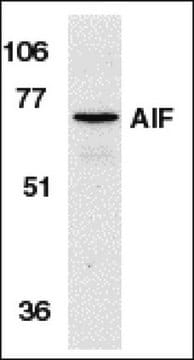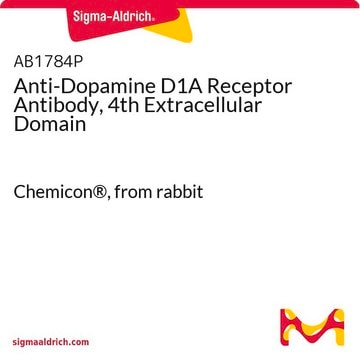AB1787P
Anti-Dopamine D4 Receptor Antibody, extracellular domain
Chemicon®, from rabbit
About This Item
Productos recomendados
origen biológico
rabbit
Nivel de calidad
forma del anticuerpo
affinity purified immunoglobulin
tipo de anticuerpo
primary antibodies
clon
polyclonal
purificado por
affinity chromatography
reactividad de especies
mouse
fabricante / nombre comercial
Chemicon®
técnicas
ELISA: suitable
western blot: suitable
Nº de acceso NCBI
Nº de acceso UniProt
Condiciones de envío
dry ice
modificación del objetivo postraduccional
unmodified
Información sobre el gen
mouse ... Drd4(13491)
Especificidad
SPECIES REACTIVITIES: The immunogen peptide shows sequence homology of 90% with rat and human D4 receptors (Van Tol et al. 1992; Legerski & Peterson 1992; Livingstone et al. 1992; Seeman et al. 1994; O′Malley et al. 1992). Antibody cross-reactivity with D4R from various species is not known.
Inmunógeno
Aplicación
Neuroscience
Neurotransmitters & Receptors
ELISA: 0.5-1.0 μg/mL (1 μg/mL immunogen peptide/well)
Not tested in immunohistochemical methods.
Optimal working dilutions must be determined by the end user.
Ligadura / enlace
Forma física
Almacenamiento y estabilidad
Otras notas
Información legal
Cláusula de descargo de responsabilidad
Not finding the right product?
Try our Herramienta de selección de productos.
Código de clase de almacenamiento
10 - Combustible liquids
Clase de riesgo para el agua (WGK)
WGK 2
Punto de inflamabilidad (°F)
Not applicable
Punto de inflamabilidad (°C)
Not applicable
Certificados de análisis (COA)
Busque Certificados de análisis (COA) introduciendo el número de lote del producto. Los números de lote se encuentran en la etiqueta del producto después de las palabras «Lot» o «Batch»
¿Ya tiene este producto?
Encuentre la documentación para los productos que ha comprado recientemente en la Biblioteca de documentos.
Nuestro equipo de científicos tiene experiencia en todas las áreas de investigación: Ciencias de la vida, Ciencia de los materiales, Síntesis química, Cromatografía, Analítica y muchas otras.
Póngase en contacto con el Servicio técnico








